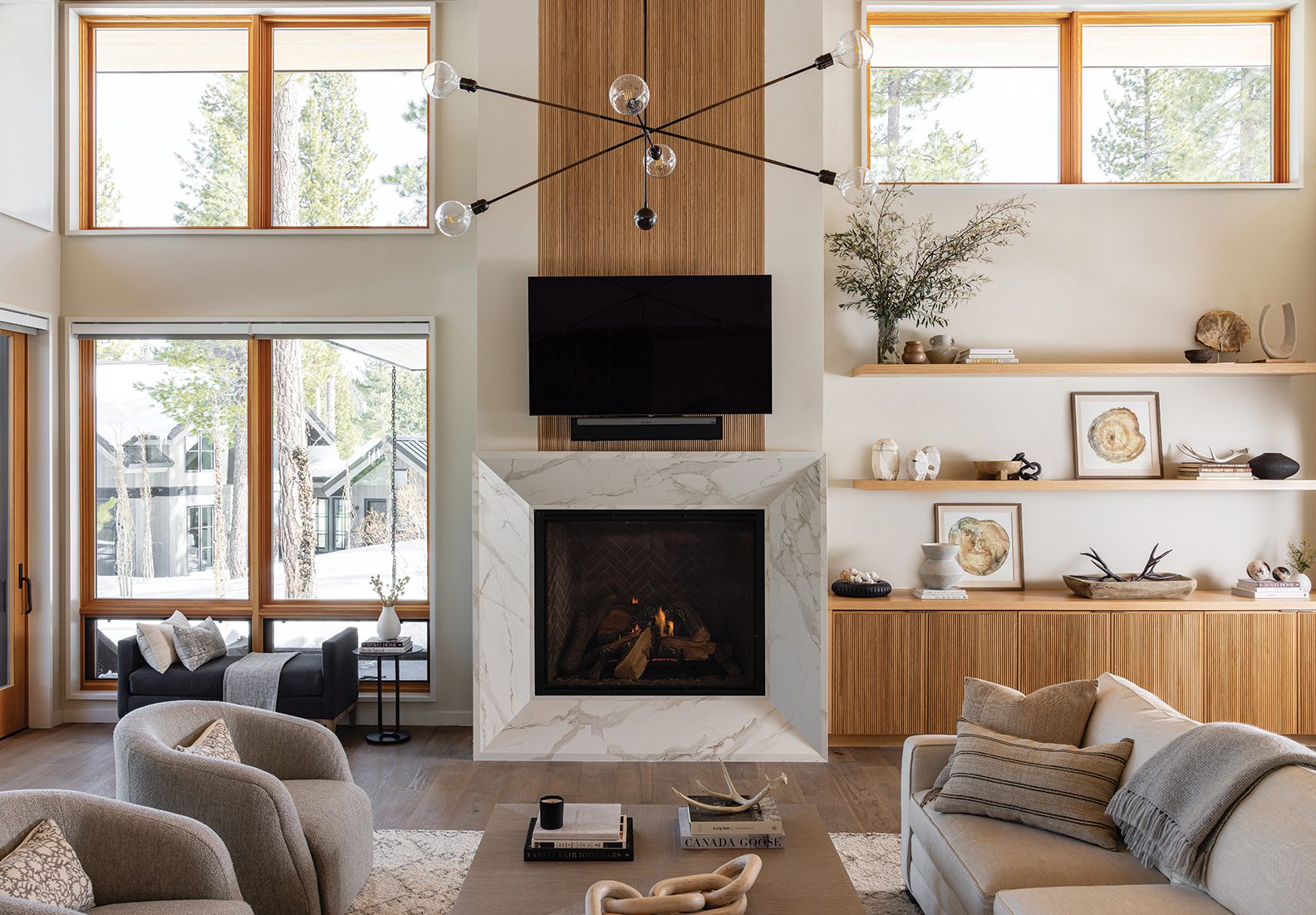
30 Apr Dream Space
How to make it to the cutting edge of interior design in Tahoe, according to three of the region’s top designers
Holly Hollenbeck, an interior designer from San Francisco, was on the search for a second home in Lake Tahoe. Growing up in the East Bay, she’d been coming to Tahoe for family vacations for most of her life, and after renting ski leases everywhere from Donner Lake to Northstar, she and her husband wanted their own place in the mountains. “Tahoe has always been part of my life and a really important place to me,” she says. After a year of searching, they closed on a house in Olympic Valley in January 2020.
“We had immaculate timing,” she says, reflecting on the global events that immediately followed.
Weeks later, pandemic orders shut down businesses and schools. Like many San Franciscans, Hollenbeck and her family fled to the mountains to live at their newly remodeled house in Tahoe while restrictions tamped down city life. In Tahoe, Hollenbeck noticed the upward trajectory of real estate.

Holly Hollenbeck founded HSH Interiors in 2002, photo by Corey Fox
“I saw the house prices just skyrocketing,” she says. “Tons of transactions and tons of people moving and buying. I said to my husband, ‘You know, I think there’s going to be a lot of work up here.’”
Hollenbeck already had an established interior design business in San Francisco, but she decided to open a Lake Tahoe satellite office. She signed a lease on an office space in downtown Truckee, in the historic Chinese Herb Shop building, and soon booked her first local project with a client she’d worked with in Mill Valley.
Four years later, Hollenbeck’s Tahoe business is still growing.
“We’ve worked really hard to get to know the local architects, the local builders, the real estate agents. We are getting referrals from all of those avenues now. I think we’re gaining some visibility in town, and I think we’re doing good work, so I hope it continues,” she says.
Luxury home construction is a thriving industry in Tahoe, with hundreds of new homes going up across the region over the past two decades. As a result, alongside architects and contractors, demand is high for skilled interior designers who can create functional, serene and beautiful spaces.
What’s more, the function and purpose of a home in Tahoe is shifting, thanks to the flexibility ushered in to adapt work cultures to the pandemic. Homeowners want a mountain retreat that can also be converted into a remote office space. They want a home built with organization in mind, so it can accommodate friends and growing families. They want a forever home where they can retire.
Every home presents a new challenge and opportunity, and that demand requires a skilled designer. It’s not coincidental that Tahoe is full of exactly that level of talent.
“There’s a wealth of riches in Tahoe, for sure, between the architect and design community,” Hollenbeck says. “For a relatively small place, it is quite flush with talent.”
Interior design is both art and science. It’s the practice of understanding human behavior and using that knowledge to create functional spaces, according to the Council for Interior Design Qualification. Put another way, interior design isn’t just about the couch you purchase before you move in. It’s a process that begins with the original concept of a house and ends with the final reveal of a room fully furnished and complete.
Tahoe’s leading interior designers are busy. The profession has always been a smart choice for people who want to build a career and live in the mountains. The path to becoming a designer, however, is not straightforward. Here’s a glimpse into the journey and business through the experiences of some of Lake Tahoe’s most sought-after designers.
Design School Calls
Before Hollenbeck was an interior designer, she worked for an investment bank, a consulting firm and a tech startup. While the experience she gained in her early career didn’t translate directly to design, it gave her a foundation in business that proved useful when she launched her own company. After the startup went under, Hollenbeck took some time off to figure out her next move. A competitive ultrarunner at the time, she spent long hours on the trail thinking about the kind of work she wanted to pursue.
“I think what I spent a lot of time thinking about on the trail was, ‘What did I enjoy as a kid? What do I really enjoy? What do I want in an office environment? What do I want my day today to look like at work?” she says.
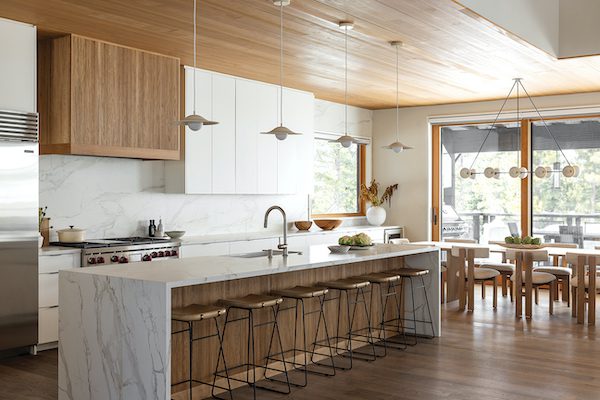
HSH Interiors applied fluted white oak to the new kitchen island and upper cabinets in this recently updated Martis Camp home, photo by Stephanie Russo
She loved drawing houses as a child, flipping through her mom’s Architectural Digests and looking at the photo spreads. And she wanted to work in a creative field with flexible hours so she could balance work with a family. She decided to try her hand at interior design, enrolling in classes at the UC Berkeley Extension. While in school, she took a job with an interior designer in San Francisco who hired her because she knew QuickBooks from working at the startup.
At the same time, Hollenbeck and her husband bought their first home in Marin County and remodeled the house. Friends and family were so impressed with Hollenbeck’s interior design work that they began asking her for help on their own homes. It was 2002 and Hollenbeck officially launched her company, HSH Interiors.
While Hollenbeck’s path to design was winding, others learned about the field through design classes in undergraduate college.
Katie Geresy, founder and designer at KTG Design in Truckee, found interest in interior design from a young age. She has stories of decorating the Thanksgiving table as a kid and painting her childhood bedroom shades of neon green and teal blue. She enrolled in the Interior Architecture Department at UC Davis.
Colette Fonseca, principal designer and founder of Altitude Design, grew up on a ranch outside of Reno and earned her interior design degree at the University of Nevada, Reno (UNR).
“I love learning things. I love rolling up my sleeves and getting to know a subject on a bigger level,” Fonseca says. “I’m also an artist. I drew and painted a lot.”
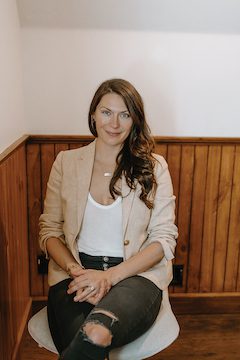
Colette Fonseca founded Altitude Design in 2019, photo by Sinead Hastings
College curricula emphasize the technical skill set of design, as well as the theories and principles behind design. At UNR, Fonseca learned software programs that designers use regularly, like SketchUp and AutoCAD. She took studio classes that allowed her to imagine an interior space, conceptualize the design, draw it out and draft plans. Psychology was also an integrated part of UNR’s interior design program.
In school, professors banned the words “because I like it,” Fonseca says, because making design-centric decisions is far more complex than personal preference.
“We need to be able to talk intelligently about the history, or the budget, or the sourcing, the elements and the principles of design, and how it fits into the entire scope of the project,” Fonseca says.
She still leans on the psychology lessons she learned in color theory and perception classes. When a client says they don’t like something, she knows what questions to ask.
“It helps me feel so in tune with my clients,” she says.
Another big aspect of Fonseca’s education was getting certified by the National Council for Interior Design Qualification (NCIDQ), which requires passing a rigorous three-part exam that goes deep into the core components of the field.
“I feel very strongly about continuing education and licensing,” she says. The NCDIQ license is “proof that you have your wherewithal, the means and the background to navigate and interpret health and safety codes, regulations.”
A college education isn’t required, however. At KTG Design, all the project managers, besides Geresy, learned on the job. Having a will to learn and an open mind will take anyone far in the interior design realm, Geresy says.
“What we look for is just drive and passion,” she says. “And in my mind, the rest of it can be taught.”
Color Theory
Interior design is one part craft and one part psychology. An eye for color, texture and materials is just as important as problem-solving to bring a client’s vision to life. The psychology of design—for example, why certain colors make people feel different emotions or affect the atmosphere of a room—is where every job begins.
“These are very personal spaces that we work in,” Fonseca says, “and the psychological part of that comes into play where it’s even deeper: It’s listening and empathizing and being respectful.”
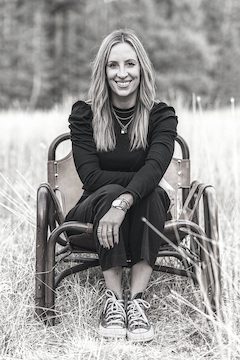
Katie Geresy grew up in Truckee and graduated from UC Davis before returning to her hometown and opening KTG Design, photo by Jenna Weston
Geresy calls these first conversations the “study phase.”
“Studying a client’s wish list and wants,” she says.
Geresy grew up in Truckee and moved back to her hometown after graduating from UC Davis and landing an internship with an interior designer. While interning, she was a sponge for knowledge and experience, which helped her develop skills that took her to a local architecture firm with a top reputation for luxury home building.
Geresy opened KTG Design more than five years ago, and today the six-person firm—including herself and her husband, who is the business manager—works with clients from start to finish: conceptualizing floor plans, managing projects during construction, overseeing furniture installation and, finally, hanging up the art on the walls and folding the bath towels in the cabinets.
“We consider ourselves a full package,” Geresy says. “We really see it from the very start to the very finish, and all the little bits in between.”
Projects can take two to three years from start to finish. With such long timelines, setting the stage for a strong relationship with the client is essential. That’s why she spends so much time at the outset of every project just having conversations with clients, getting to know them and understanding their directions, goals and personalities.
“We’re not always the right fit for someone, and someone might not necessarily be the right fit for us, too,” Geresy says. “We want to make sure we get to know someone prior to starting any project, really getting into the weeds of understanding someone’s directions and goals and personality.”
The study phase is where inspiration gets compiled alongside the project’s design specifications, budgets and timeline. Geresy says she doesn’t have a style preference. Interior design is custom-made to fit the client’s taste and preferences.
It’s All About Who You Know
When Fonseca opened the doors to Altitude Design in 2019, she started small. A local architect who’d become her mentor introduced her to some of her first clients as an independent designer.
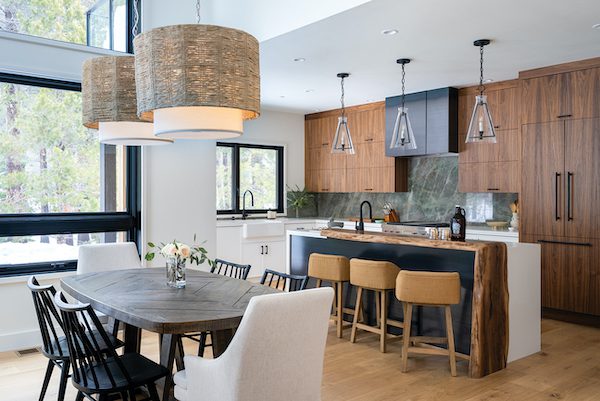
In this home on Donner Creek, interior designer Colette Fonseca and her Altitude Design team embraced natural materials and textures, which are showcased in the kitchen with harmonizing rich walnut wood tones and natural Jadore quartzite against pristine white quartz counters. The natural abaca dining pendants soften the space and offer a scale commensurate with the vaulted ceilings, photo by Sinead Hastings
“I knew that my best asset was my time and my skill. So I knew that, at least, I could have very, very little overhead and just bill for my time,” she says.
In a tight-knit field like the home-building industry in Tahoe, relationships are vital, not just on the client side but also with other professionals. Most local interior designers have established relationships with leading architects and contractors in the region, who refer business.
Relationships are also key because the interior designer is often the mediator between the build team and client. Geresy says she’ll go to a build site to check on the project’s status on behalf of the client. That’s one of the reasons out-of-town homeowners hire a Tahoe-based designer.
“We’re right here. We’re present,” Geresy says. “We’re the eyes and ears on the ground while they’re otherwise not here.”
Having a physical presence in Tahoe is crucial to success in this market, Hollenbeck says.
“Our jobs are generally large-scale remodeling, or ground-up construction projects, and we furnish. So we have a full-time staff in the area. It means we are really, really hands-on with our projects,” says Hollenbeck, who also puts in a concerted effort to build relationships locally.
She hosted a party in early March, inviting plumbers, electricians, engineers, architects, real estate agents—anyone who works in the home-building industry. Knowing other professionals makes her a more effective designer for her clients. If a client wants to work with a local artisan, she knows who to call.
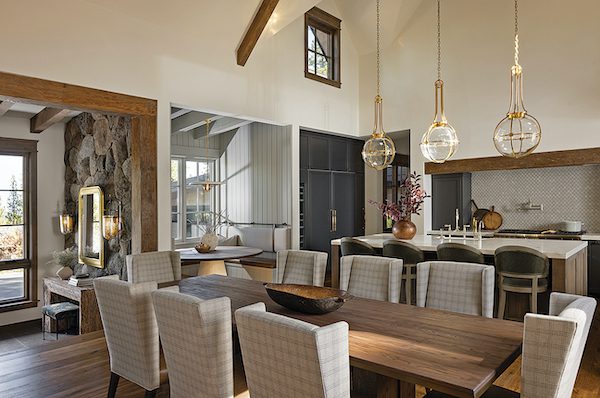
Rich hues embrace guests in tranquil elegance in this serene dining and kitchen space by KTG Design, photo by Stephanie Russo
“We know who does the best drapery. We know who does the best upholstery. We know who can refinish woodwork. We just have those connections,” she says.
Hollenbeck has the added advantage of her office in San Francisco, where most of her clients live. That means clients in the city can pop over to the office for a lunch meeting to pick out fabric for the Tahoe house, and her Tahoe team can then bring those fabric samples to the construction site.
“We take the process very seriously,” Hollenbeck adds. “It’s usually a very large investment. Building a home is a big deal. And clients want to have a level of surety, clarity, understanding of the process. They want to have clear steps and clear guidance. And that’s something that, with over 20 years of experience, I know we can provide.”
Another key to success is consistent, clear communication, Geresy says. Much of her workday involves writing up reports for clients to keep them updated on a project, sending emails and picking up the phone to have those hard conversations when issues inevitably arise.
“Being able to have that communication line with the client, like, ‘Hey, I think we need to move this window,’ or, ‘We should do this treatment slightly differently.’ They tend to trust that and appreciate those candid conversations,” Geresy says.
The COVID Spike
For the housing industry in Tahoe, the pandemic was fuel to an already healthy fire, which upended any ideas Fonseca had for slow, steady growth.
“What I thought would definitely be the detriment and just elimination of my livelihood and my income and my business actually became the jumping off point,” Fonseca says of the pandemic. “I wish I could have scaled slower, but there was no way. There was so much work.”
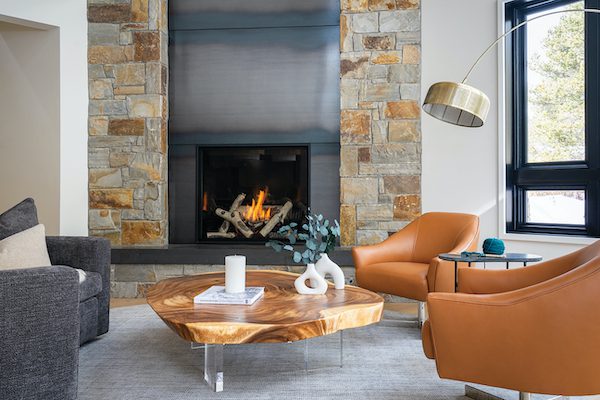
This Donner Creek home by Altitude Design features an angled fireplace in the living room made of Wyoming Split stone and hot rolled steel, as well as a natural acacia coffee table with acrylic legs to give a floating effect, photo by Sinead Hastings
She adds, “People have COVID babies and COVID puppies. I have a COVID business.”
Five years after starting her company, Fonseca has two employees, a much better work-life balance and a portfolio of gorgeous homes she designed.
Geresy started her business in 2018 and also experienced a boom thanks to an influx of people relocating to Tahoe after the pandemic.
“It was a wild time for a couple of years,” she says. “This year, I think I’m starting to see that it’s starting to normalize again.”
The demand for second homes remains high, however.
“For most of our clients, they are building what they see as the family home for the next 30 years,” Hollenbeck says. “So someday it will become their full-time residence but for now it’s a second home.”
Compared to San Francisco, Hollenbeck says her Tahoe projects tend to be new builds. That gives interior designers a larger canvas, which helps when creating spaces for multiple generations, winter and summer vacations, and remote work.
“Every bedroom we’re doing these days has a built-in desk,” Hollenbeck says. “We put in sufficient storage so that people can stay there long term and they can work remotely.”
Final Reveal
What’s next for interior designers in Tahoe? For Hollenbeck, it’s continuing to broaden her local connections and become more established here. She also wants to pursue different kinds of projects. She’s recently finished the design work for a luxury condominium project underway in Incline Village, which sparked her interest in multi-family design and, perhaps someday, boutique hotels.
“I don’t like to do the same thing over and over again, which is in part why our projects are kind of radically different from one another,” Hollenbeck says. “I like to be challenged. I like to think out of the box.”
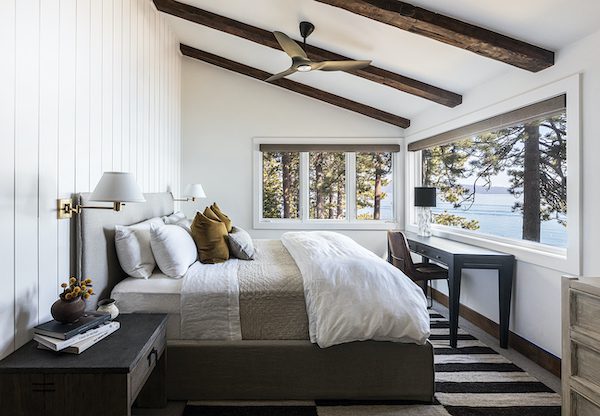
This cozy lakeside bedroom by KTG Design offers more than just a view—it’s a window to serenity, photo by Kat Alves
Fonseca says she’s working on projects with the modern aesthetic that’s become ubiquitous in Tahoe, but that the modern mountain design is starting to shift in the details, with added texture and handcrafted touches, or moody color palettes.
Her tip to aspiring designers is to stay curious and when something sparks your interest, go deep on it. “Immerse yourself,” she says. Interior design “is really beautiful and fun. Get curious about it.”
And take good notes, she adds.
Interior design is a demanding profession. But however great the effort, the reward at the end—unveiling a finished house to the client—is something special.
“We always try to do the install and not have the client around, so they can walk into a completed or finished space,” Geresy says. “And just seeing that reaction. It goes a long way. It really means so much to us.”
Julie Brown Davis is a freelance writer who finds joy in organizing a good bookshelf.




No Comments